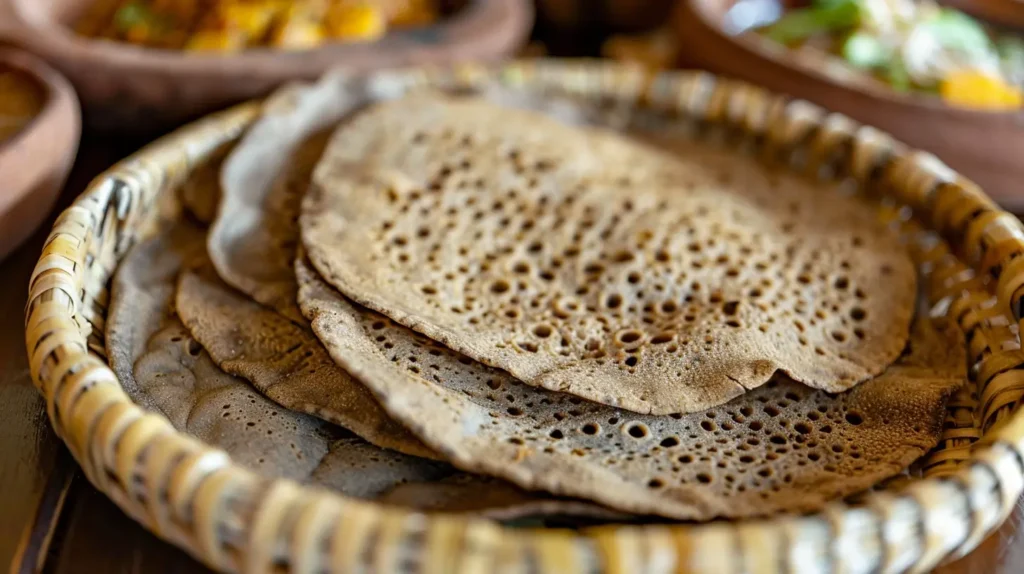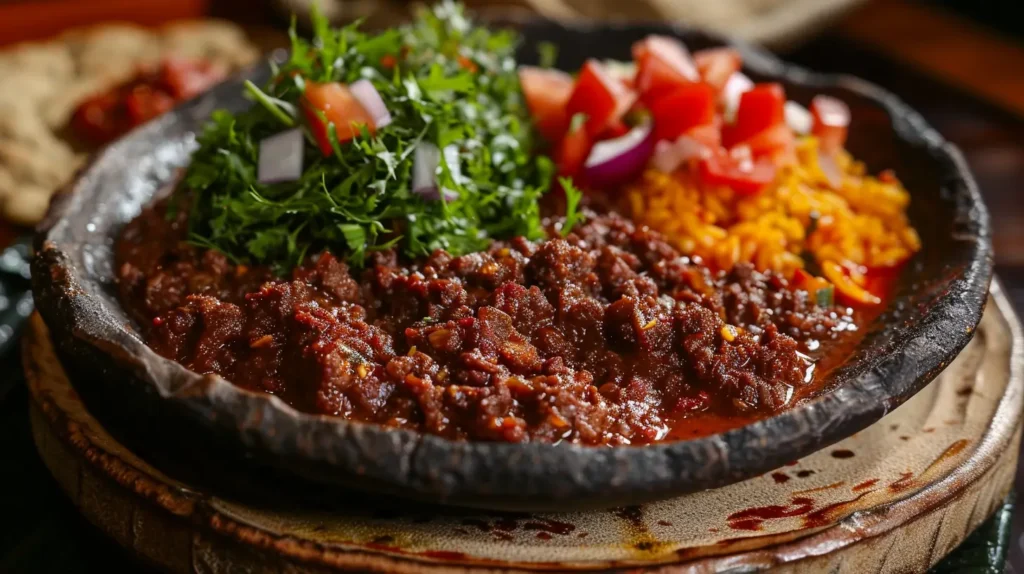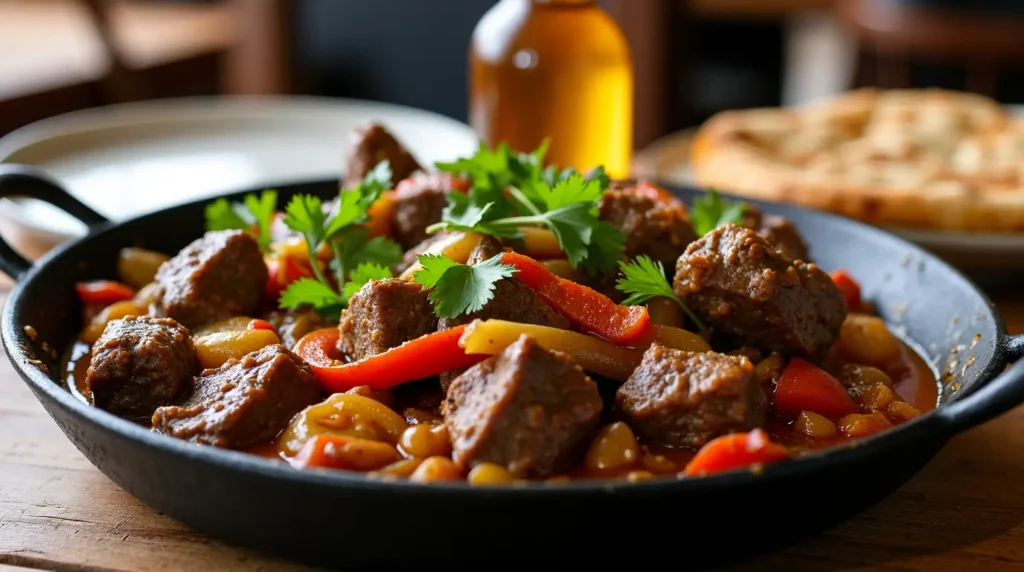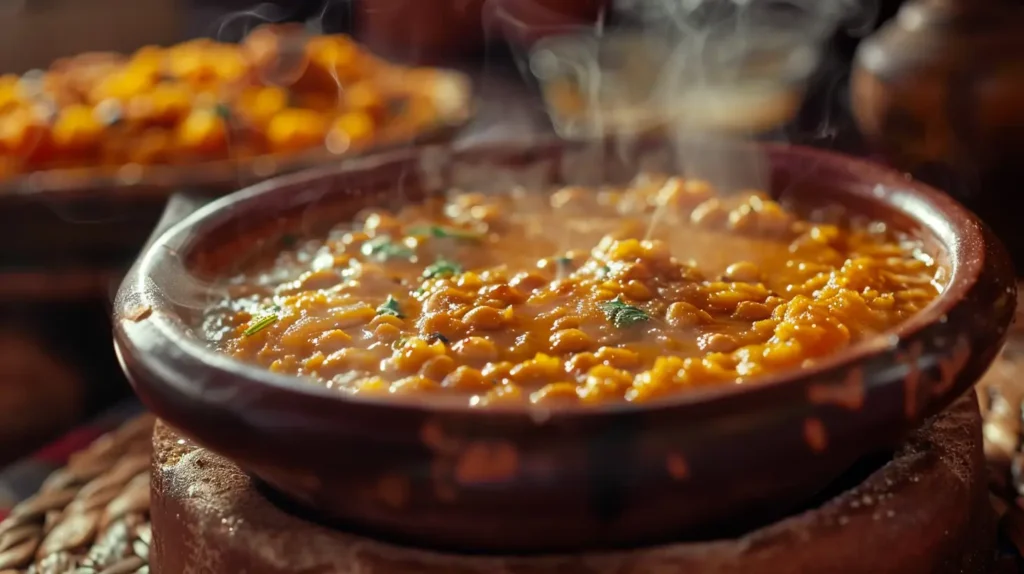Table of Contents
Table of Contents
Introduction
Ethiopia’s culinary heritage is as rich and diverse as the country’s storied history. Characterized by vibrant flavors, communal dining practices, and a wide variety of spices, Ethiopian cuisine has captured the hearts (and taste buds) of food enthusiasts worldwide. Whether enjoyed in the buzzing capital of Addis Ababa or in a remote village perched on the highlands, Ethiopian meals emphasize sharing, hospitality, and the deep connection between food and cultural identity. Diners often gather around large platters of injera—the spongy, sourdough flatbread ubiquitous in Ethiopian dining—and scoop up richly seasoned dishes with their hands. These communal meals not only showcase Ethiopian flavors but also reflect the country’s strong sense of community and tradition.
In this article, we will delve into the many facets that make Ethiopian cuisine truly unique and compelling. We will explore its historical and cultural roots, highlight the key ingredients that shape its signature dishes, and offer insights into traditional meals you simply must try. We will also discuss the sensory characteristics—spicy, tangy, and aromatic—that define Ethiopian gastronomy and encourage gastronomes worldwide to explore these tantalizing flavors. Finally, we will touch on the social and ceremonial aspects of Ethiopian dining, from coffee ceremonies to holiday feasts, and consider how modern influences are shaping a new generation of Ethiopian culinary experiences. By the end of this comprehensive guide, you will be well-versed in everything that makes Ethiopian cuisine one of the most vibrant and celebrated food cultures in the world.
Culinary Context and History
The Evolution of Ethiopian Cuisine Over Time
Ethiopian cuisine’s roots can be traced back thousands of years. Situated in the Horn of Africa, Ethiopia’s geography—marked by highlands, fertile valleys, and desert regions—has long dictated the cultivation of grains, legumes, and spices. Early agricultural societies in Ethiopia primarily grew teff, a tiny yet nutrient-rich grain that remains a staple today. Over the centuries, other grains like barley, sorghum, and wheat found their way into Ethiopian farms, forming the backbone of the country’s daily diet.
Historically, Ethiopia maintained its independence through various epochs, setting it apart from many African nations that experienced prolonged colonial rule. Although there was a brief period of Italian occupation (1936–1941), Ethiopia largely preserved its traditional institutions and cultural identity, including its culinary practices. This continuity ensured the survival of age-old recipes and techniques that many Ethiopians still use in their kitchens today. Ethiopian cuisine, deeply rooted in tradition, remained largely intact despite foreign influences. During the Italian occupation, for instance, pasta and tomato-based sauces made their way into Ethiopian cooking, but these influences were adapted to Ethiopian tastes and overshadowed by more dominant local flavors.
Cultural, Religious, and Geographical Influences
Religious practices, especially Ethiopian Orthodox Christianity, have played a pivotal role in shaping Ethiopian cuisine. Throughout much of Ethiopia, adherents observe fasting periods on several days of the week, abstaining from meat and animal products. As a result, vegetarian and vegan-friendly dishes, such as shiro (chickpea or broad bean stew) and misir wot (lentil stew), are deeply ingrained in the food culture. Many families, whether for religious or personal reasons, regularly consume these flavorful plant-based dishes, which are now drawing international attention as healthy, protein-rich options.
Geographically, Ethiopia’s location near the Red Sea and the Gulf of Aden facilitated trade with the Middle East, India, and the broader Mediterranean region. Historically, spices like cumin, cardamom, and cinnamon arrived via maritime trade routes, melding with native ingredients to create the characteristic Ethiopian spice blends we know today—most notably berbere (a mix of chili peppers, garlic, ginger, fenugreek, and other warming spices). Additionally, contact with neighboring East African countries, as well as Indian merchants, influenced the use of legumes and aromatic seasonings.
Major Historical Events and Key Periods
- Aksumite Kingdom (1st–7th centuries CE): The ancient Kingdom of Aksum was a significant trading empire that connected Africa with the Middle East and Asia. Spices, precious metals, and other goods traversed the routes that cut through Ethiopia, forever linking local cuisine to global flavors.
- Zagwe Dynasty and Solomonic Dynasty (10th–18th centuries): Despite internal power shifts, Ethiopia continued to interact with the outside world through trade and diplomatic missions, exchanging ideas and goods, including new spices and cooking methods.
- Brief Italian Occupation (1936–1941): Italian staples such as pasta and tomato sauces made minor inroads, but Ethiopians largely held onto their deeply entrenched cooking traditions.
- Modern Era and Diaspora (20th century–present): As Ethiopians migrated to various parts of the world, they brought their cuisine with them, establishing restaurants and markets abroad that introduced and popularized dishes like doro wat and kitfo.
Regional Culinary Differences
Although injera and an array of wat (stews) are widespread, the cuisine varies notably from north to south and east to west:
- Northern Highlands (e.g., Tigray, Amhara): Known for robust, spicy stews and the frequent use of teff injera. Traditional dishes here heavily feature lamb and beef, often flavored with berbere or spiced butter called niter kibbeh.
- Southern Regions (e.g., Sidama, Wolaita): Root crops like enset (false banana) play an essential role, and dishes may have milder spice levels but still rely on aromatic herbs. Fermented products and dairy (when not fasting) are also common.
- Eastern Lowlands (e.g., Harar, Somali-influenced areas): Characterized by more pastoralist traditions, the cuisine integrates more meat-based dishes, sometimes roasted or grilled, served alongside injera. Influences from Arab and Somali cuisine show up in the form of seasoned rice or flatbreads.
- Western Regions (e.g., Gambella, Benishangul-Gumuz): This area’s lush environment allows for the cultivation of various legumes and grains, with recipes often showcasing unique local produce. Stews may be lighter in spice intensity compared to the highland dishes.
Ethiopia’s long history of regional diversity and cultural exchange has led to Ethiopian cuisine, which is both unified by staple elements like injera and profoundly nuanced by local culinary traditions.
Key Ingredients and Local Products
Emblematic Foods and Spices
- Teff: The tiny, gluten-free grain at the heart of Ethiopian cuisine, used predominantly to make the beloved injera. Available in both brown and white varieties, teff is prized for its nutritional profile, rich in iron, protein, and fiber.
- Berbere: A fiery, aromatic spice blend that defines many Ethiopian stews. Berbere typically includes chili peppers, fenugreek, ginger, garlic, and a range of other spices that may vary according to family or regional recipes.
- Niter Kibbeh: Clarified butter simmered with garlic, ginger, onions, and other spices like cardamom, basil, or fenugreek. It adds an incomparable depth of flavor to many traditional dishes.
- Shiro: A powder made from ground chickpeas or broad beans, sometimes fortified with berbere, then cooked into a thick stew. It is a staple dish during fasting periods.
- Mitmita: A hotter spice blend than berbere, typically incorporating ground bird’s eye chili peppers, cardamom, cloves, and salt. Used in dishes that require a bigger kick, such as kitfo (minced meat).
- Legumes: Lentils, split peas, chickpeas, and fava beans frequently star in Ethiopian cooking, reflecting both religious practices and the local palate for hearty, plant-based protein.
- Enset (False Banana): Common in the southern regions, this plant is not the same as the sweet banana. Its root or corm is fermented and used to make a food called kocho, an important staple for communities in the south.
- Fresh Herbs: Basil, rosemary, thyme, and oregano often appear in Ethiopian kitchen gardens. These herbs, paired with spices, help craft the layered flavors characteristic of Ethiopian meals.
Seasonality and Its Impact
Ethiopia’s climate and agriculture vary significantly by region. In the highlands, the rainy season occurs roughly between June and September, which affects the availability of fresh produce and influences which ingredients families rely on. During the rainy season, staple grains such as teff and barley are cultivated, and after harvest, these become central to day-to-day cooking. In drier regions, pastoralist communities may rely more on livestock products like milk and butter, blending them into stews or using them for cooking. These diverse agricultural conditions contribute to the richness of Ethiopian cuisine, where regional ingredients shape unique flavors and cooking techniques.
Festive times, often aligned with religious calendars (such as Easter or Meskel in the Ethiopian Orthodox Church), bring an abundance of meat-based dishes. Families save up for the feast days to afford high-quality cuts of beef, chicken, or lamb. Conversely, during fasting seasons such as Lent, nearly all animal products are off the menu, inspiring an elaborate array of purely plant-based creations.
Tips on Purchasing Ethiopian Ingredients
If you live outside of Ethiopia and wish to recreate Ethiopian dishes:
- Local Ethiopian Markets or Grocery Stores: Many major cities worldwide have Ethiopian grocery stores or shared African markets where you can purchase fresh injera, berbere, and other authentic products.
- Online Specialty Retailers: A growing number of retailers sell teff flour, berbere spice mixes, and other key ingredients online, making it easier than ever to source everything you need.
- Substitutions: If you can’t find teff flour, you can experiment with mixes of whole wheat and rye flours to approximate the taste and texture of traditional injera. However, for the most authentic experience, teff remains irreplaceable.
- Fresh Spices: Whenever possible, buy whole spices and grind them at home. This approach ensures maximum flavor and aroma, closely mirroring Ethiopian culinary practices.
Must-Try Traditional Dishes of Ethiopian Cuisine
Injera

History and Characteristics
Injera is the cornerstone of Ethiopian cuisine. Typically made from fermented teff batter, injera has a tangy flavor and a distinctive porous texture that absorbs the sauces of accompanying dishes. Beyond being a mainstay carbohydrate, injera doubles as an edible utensil. Its communal nature reflects the essence of Ethiopian dining: sharing from the same plate.
Simplified Injera Recipe
- Ingredients: 2 cups teff flour (or a blend of teff and wheat flour if teff is scarce), 3 cups water, a pinch of salt.
- Instructions:
- Ferment: Mix flour, water, and salt in a large bowl, cover with a cloth, and leave it to ferment at room temperature for 2–3 days. The batter should develop a slightly sour aroma.
- Thin the Batter: After fermentation, stir well. The consistency should be thinner than pancake batter.
- Cook: Heat a non-stick pan over medium heat. Pour enough batter to form a thin layer. Cover with a lid. As holes form on the surface (like a honeycomb), remove the lid and let it cook briefly. The injera is done when the edges begin to peel away from the pan.
- Serve: Stack on a plate, letting each piece cool slightly. Injera is best served fresh with various stews.
Doro Wat

History and Characteristics
Arguably the most famous dish in Ethiopian cuisine, doro wat is a slow-cooked chicken dish simmered in a rich, spicy sauce heavily seasoned with berbere and niter kibbeh. It often includes whole hard-boiled eggs, which soak up the sauce’s intense flavors. Doro wat is traditionally prepared for special occasions and family gatherings, such as Ethiopian New Year (Enkutatash) or Easter.
Simplified Cooking Tips
- Ingredients: Chicken drumsticks, onions, berbere, garlic, ginger, niter kibbeh (or clarified butter), hard-boiled eggs, salt.
- Method:
- Caramelize a generous amount of finely chopped onions in a pot (with little to no oil initially, as Ethiopian stews rely heavily on onions for moisture).
- Add berbere, garlic, and ginger to form a paste.
- Incorporate niter kibbeh for depth of flavor, then add chicken pieces and simmer gently.
- Adjust seasoning and nestle in the hard-boiled eggs during the final stages.
Kitfo

History and Characteristics
Originating from the Gurage region, kitfo is minced beef seasoned with mitmita and niter kibbeh. It can be served raw (traditional style), lightly cooked, or fully cooked according to preference. For those new to Ethiopian cuisine, semi-cooked kitfo might be the perfect introduction, offering a balanced showcase of the dish’s unique seasoning without fully embracing the traditional raw texture.
Tibs

History and Characteristics
Tibs refers to sautéed meat (often beef, lamb, or goat) cooked in a pan with onions, peppers, and spices. It can range from mild to very spicy, depending on the addition of berbere or fresh chilies. This dish is popular for both everyday meals and celebratory occasions, reflecting the versatility of Ethiopian cuisine and its diverse cooking techniques.
Shiro Wot

History and Characteristics
A vegetarian staple in Ethiopian Cuisine, shiro wot is a chickpea or broad bean flour stew that exemplifies simplicity and rich flavor. Cooked with onions, garlic, berbere, and sometimes tomatoes, shiro becomes luxuriously thick and smooth. During fasting seasons or for a light family meal, shiro wot is a go-to dish often paired with injera.
Regional Variations
- Gomen (Collard Greens): In the northern highlands, collard greens may be slow-cooked with onions, garlic, and ginger, sometimes with niter kibbeh for a buttery finish. In other regions, kale or spinach might be used if collard greens are unavailable.
- Fossolia (Green Beans and Carrots): Another side dish popular across regions, although seasoning levels can vary from mild to spicy.
- Kocho and Enset-Based Dishes: In the southern regions, enset-based bread (kocho) is the primary starch. Kocho can be served with meat dishes, vegetable stews, or even kitfo, representing a stark contrast to the teff-based diets of the north.
Defining Characteristics of Ethiopian Cuisine
A Symphony of Spice and Tang
Spice is integral to Ethiopian cooking. Berbere, mitmita, and niter kibbeh collectively impart a bold, multi-layered taste, often balanced by the tangy sourness of injera. The heat level can vary considerably, meaning not all dishes are scorchingly hot—some are mildly spiced and rely more on the fragrant complexity of ginger, garlic, and onions.
Communal Dining Culture
Ethiopian cuisine is almost always shared. One large platter of injera topped with assorted stews invites diners to eat together from the same plate, symbolizing unity, respect, and camaraderie. This tradition underscores the warmth and inclusivity inherent in Ethiopian society.
Veg-Friendly and Meat-Lover’s Paradise Alike
The presence of extensive fasting periods in Ethiopian Orthodox Christianity has led to the development of a wide variety of vegan dishes that do not sacrifice flavor. Ethiopian cuisine effortlessly satisfies vegetarians, vegans, and omnivores alike, which is increasingly appealing in modern culinary scenes worldwide.
Unique Flavor Combinations
Expect to find warming spices such as cinnamon, cardamom, cumin, fenugreek, and clove blended in ways that may be new to many palates. The addition of clarified butter infused with herbs enhances the stew-like dishes, creating a distinctive, almost velvety mouthfeel. Food enthusiasts looking for something new, complex, and culturally rich will find Ethiopia a culinary treasure.
Tips and Highlights to Encourage People to Try This Cuisine
- Cultural Exploration: Trying Ethiopian cuisine is a gateway to experiencing a millennia-old culture known for its music, dance, coffee ceremony, and striking landscapes.
- Health Benefits: Many Ethiopian dishes use nutrient-dense legumes and grains, like teff and lentils. The cuisine’s heavy reliance on onions, garlic, and ginger also offers health advantages.
- Social Dining: If you enjoy interactive, communal dining experiences, Ethiopian meals are perfect. Sharing a single platter fosters connection and conversation.
- Adventure for Spice Lovers: The interplay of flavors in berbere, mitmita, and niter kibbeh offers new and exciting taste sensations, especially for those who appreciate spicy or aromatic cuisines.
- Coffee Ceremony: Beyond the food, Ethiopia’s coffee ceremony is an important part of local hospitality. Experiencing freshly roasted and brewed Ethiopian coffee, accompanied by popcorn or peanuts, is an absolute must.
Table Rituals and Customs
Typical Meals in Ethiopia
- Breakfast: Many Ethiopians start the day with fit-fit (or firfir), which is shredded injera mixed with berbere sauce or tomato-based sauce. Another common breakfast item is fool—a fava bean stew served with fresh bread. For a lighter morning, genfo (a thick porridge) may also be prepared.
- Lunch and Dinner: These are usually centered around injera with a variety of wot (stews). The main difference between lunch and dinner might be portion size or the variety of stews offered, but both meals emphasize communal dining.
- Snacks or Between-Meals: Street foods such as sambusa (fried pastry filled with spiced lentils or meat) or roasted barley (known as kolo) can be common midday treats. Some communities also enjoy buna qela—coffee beans coated in spices and butter—during social gatherings.
Table Etiquette and Local Traditions
- Gursha: This is the act of picking up a morsel of food using injera and feeding it directly to another person. It is a sign of affection and respect.
- Right Hand Only: Traditionally, Ethiopians eat with the right hand. Using the left hand is considered unclean. Many restaurants providing Ethiopian food offer utensils if requested, but eating with your hand is part of the authentic experience.
- Fasting Practices: During fasting days or seasons, restaurants and homes prepare a ye-tsom (fasting) platter, comprising exclusively vegan stews like shiro, gomen, misir wot, and atkilt wot (cabbage, carrots, potatoes). It is respectful to be aware of these customs if you are dining with Ethiopian friends or visiting Ethiopia during such periods.
National Holidays and Religious Events
- Genna (Ethiopian Christmas): Celebrated on January 7th, Genna is a time when families gather for large feasts. Doro wat is often a highlight.
- Timket (Epiphany): Taking place in January, Timket is a significant religious festival that includes processions and communal meals. Meat-based dishes are common, as it follows a lengthy fasting period.
- Meskel: Commemorated in late September, Meskel celebrates the finding of the True Cross according to Ethiopian tradition. Feasting, dancing, and large public bonfires mark the occasion.
- Enkutatash (Ethiopian New Year): Celebrated on September 11th, Enkutatash features lavish meals, often including fresh produce and meat to mark a new beginning.
During these holidays, family, friends, and neighbors come together to share not just food but also music, dances, and deeply ingrained traditions. Ethiopian cuisine plays a central role in these celebrations, with food preparation for festivals often spanning days, reflecting the importance of these communal feasts.
Modern Trends and Culinary Fusions
Evolving Through Contact with Other Gastronomies
Thanks to Ethiopia’s growing diaspora, Ethiopian cuisine has become more widely recognized, especially in global cities like Washington, D.C., London, and Dubai. In these international contexts, chefs often adapt recipes to suit local palates or incorporate modern cooking techniques. Fusion dishes have emerged, blending Ethiopian spices and style with Italian, Middle Eastern, or even Asian influences.
An example includes Berbere-Spiced Pasta, a nod to the historically brief Italian presence in Ethiopia. Chefs might also incorporate teff flour into pancakes, waffles, or even dessert pastries, capitalizing on its nutritional profile and unique flavor.
New Consumption Trends
- Vegetarianism and Veganism: The Ethiopian Orthodox tradition of fasting from animal products has effectively created a strong foundation for plant-based eating. Many Ethiopian restaurants now label these dishes as vegan-friendly, meeting growing global demand.
- Farm-to-Table and Organic: Younger Ethiopian chefs and restaurateurs are keen to emphasize quality local produce. They partner with small-scale farmers to source organic teff, vegetables, and spices, thereby supporting sustainable agriculture and ensuring fresher dishes.
- Gluten-Free and Health Conscious: Teff flour is naturally gluten-free, making injera a sought-after alternative for those with gluten sensitivities. This aspect of Ethiopian cuisine resonates with modern health trends worldwide.
Notable Young Chefs and Restaurateurs
A new wave of Ethiopian chefs is reinventing traditional dishes in upscale, contemporary settings:
- Chef X in Addis Ababa offers modern plating for classics like doro wat, garnishing it with microgreens and presenting injera in bite-sized cones.
- Chef Y in Los Angeles fuses Ethiopian and Mexican flavors, serving berbere-marinated tacos wrapped in teff tortillas.
- Chef Z in Europe experiments with molecular gastronomy, deconstructing kitfo and presenting it with foam versions of niter kibbeh and injera crisps.
These innovations showcase how Ethiopian cuisine is not static but rather a dynamic culinary tapestry, continuously enriched by modern culinary thought and global exchanges.
Conclusion and Call to Action
Ethiopian cuisine stands at the intersection of deep-rooted traditions, diverse cultural influences, and a modern spirit of experimentation. From its origins in the ancient highlands to the bustling diaspora communities worldwide, this flavorful food culture remains unmistakably Ethiopian—built around injera, bold spice blends, communal dining, and a respect for heritage. Whether you are a spice enthusiast craving fiery berbere-infused stews or a vegan eager to explore sumptuous plant-based dishes, Ethiopia’s gastronomic landscape offers something for every palate.
We have covered the historical contexts that shaped Ethiopian gastronomy, highlighted key ingredients like teff and berbere, and introduced you to dishes you simply must try—such as doro wat, kitfo, and shiro. We also explored the significance of communal dining, religious fasting, and traditional customs like gursha that foster shared experiences and cultural pride. Modern chefs are taking Ethiopian cuisine in innovative directions, making use of farm-to-table practices, fusion recipes, and contemporary presentations to reach new audiences.
Now, it’s your turn to embark on this culinary journey. If you have had the opportunity to try Ethiopian cuisine or if you decide to test out an injera recipe in your own kitchen, let us know about your experience. Did you master the tangy taste of authentic injera? Did you find the right balance of spices for doro wat? Perhaps you discovered an entirely new flavor sensation that you are eager to share. We encourage you to comment with your stories, favorite recipes, or any questions you may have.
Looking ahead, we hope to dive deeper into the art of the Ethiopian coffee ceremony in a future article, exploring the symbolism behind every step and the subtle nuances of Ethiopian coffee varieties. Stay tuned for more on that quintessential aspect of Ethiopian culture—and, until then, enjoy the flavorful adventure that is Ethiopian cuisine.

